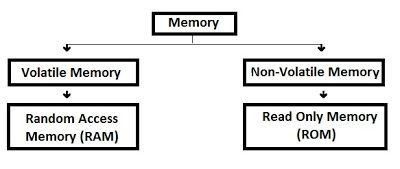Computer Memory ? Different Types Of Memory In Computer With Examples
COMPUTER MEMORY
Memory is an essential element of a computer. Without its memory, a computer is of hardly any use. Memory plays an important role in saving and retrieving data. The performance of the computer system depends upon the size of the memory. Memory is of following types:
1. Primary Memory / Volatile Memory.
2. Secondary Memory / Non Volatile Memory.

1. Primary Memory / Volatile Memory: Primary Memory is internal memory of the computer. RAM AND ROM both form part of primary memory. The primary memory provides main working space to the computer.The following terms comes under primary memory of a computer are discussed below:
Random Access Memory (RAM): The primary storage is referred to as random access memory (RAM) because it is possible to randomly select and use any location of the memory directly store and retrieve data. It takes same time to any address of the memory as the first address. It is also called read/write memory. The storage of data and instructions inside the primary storage is temporary. It disappears from RAM as soon as the power to the computer is switched off. The memories, which lose their content on failure of power supply, are known as volatile memories .So now we can say that RAM is volatile memory.
Read Only Memory (ROM): There is another memory in computer, which is called Read Only Memory (ROM). Again it is the ICs inside the PC that form the ROM. The storage of program and data in the ROM is permanent. The ROM stores some standard processing programs supplied by the manufacturers to operate the personal computer. The ROM can only be read by the CPU but it cannot be changed. The basic input/output program is stored in the ROM that examines and initializes various equipment attached to the PC when the power switch is ON. The memories, which do not lose their content on failure of power supply, are known as non-volatile memories. ROM is non-volatile memory.
PROM: There is another type of primary memory in computer, which is called Programmable Read Only Memory (PROM). You know that it is not possible to modify or erase programs stored in ROM, but it is possible for you to store your program in PROM chip. Once the programmers’ are written it cannot be changed and remain intact even if power is switched off. Therefore programs or instructions written in PROM or ROM cannot be erased or changed.
EPROM: This stands for Erasable Programmable Read Only Memory, which overcome the problem of PROM & ROM. EPROM chip can be programmed time and again by erasing the information stored earlier in it. Information stored in EPROM exposing the chip for some time ultraviolet light and it erases chip is reprogrammed using a special programming facility. When the EPROM is in use information can only be read.
Cache Memory: The speed of CPU is extremely high compared to the access time of main memory. Therefore the performance of CPU decreases due to the slow speed of main memory. To decrease the mismatch in operating speed, a small memory chip is attached between CPU and Main memory whose access time is very close to the processing speed of CPU. It is called CACHE memory. CACHE memories are accessed much faster than conventional RAM. It is used to store programs or data currently being executed or temporary data frequently used by the CPU. So each memory makes main memory to be faster and larger than it really is. It is also very expensive to have bigger size of cache memory and its size is normally kept small.
Registers: The CPU processes data and instructions with high speed; there is also movement of data between various units of computer. It is necessary to transfer the processed data with high speed. So the computer uses a number of special memory units called registers. They are not part of the main memory but they store data or information temporarily and pass it on as directed by the control unit.
2. Secondary Memory / Non-Volatile Memory: Secondary memory is external and permanent in nature. The secondary memory is concerned with magnetic memory. Secondary memory can be stored on storage media like floppy disks, magnetic disks, magnetic tapes, This memory can also be stored optically on Optical disks - CD-ROM. The following terms comes under secondary memory of a computer are discussed below:
Magnetic Tape: Magnetic tapes are used for large computers like mainframe computers where large volume of data is stored for a longer time. In PC also you can use tapes in the form of cassettes. The cost of storing data in tapes is inexpensive. Tapes consist of magnetic materials that store data permanently. It can be 12.5 mm to 25 mm wide plastic film-type and 500 meter to 1200 meter long which is coated with magnetic material. The deck is connected to the central processor and information is fed into or read from the tape through the processor. It’s similar to cassette tape recorder.
Magnetic Disk: You might have seen the gramophone record, which is circular like a disk and coated with magnetic material. Magnetic disks used in computer are made on the same principle. It rotates with very high speed inside the computer drive. Data is stored on both the surface of the disk. Magnetic disks are most popular for direct access storage device. Each disk consists of a number of invisible concentric circles called tracks. Information is recorded on tracks of a disk surface in the form of tiny magnetic spots. The presence of a magnetic spot represents one bit and its absence represents zero bit. The information stored in a disk can be read many times without affecting the stored data. So the reading operation is non-destructive. But if you want to write a new data, then the existing data is erased from the disk and new data is recorded. For Example-Floppy Disk.
Optical Disk: With every new application and software there is greater demand for memory capacity. It is the necessity to store large volume of data that has led to the development of optical disk storage medium. Optical disks can be divided into the following categories:
Compact Disk/ Read Only Memory (CD-ROM
Write Once, Read Many (WORM)
Erasable Optical Disk



